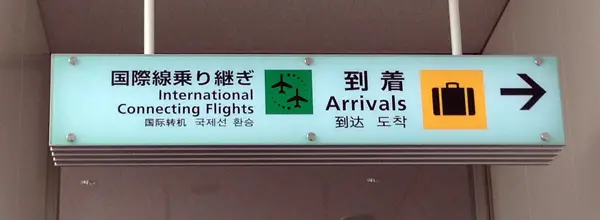Haneda Airport, formerly known as Tokyo International Airport, is one of the two main airports that serve the Tokyo metropolis, the other one being Narita International Airport. As I was flying out of Beijing on board of Air China’s A321, the plane landed at Haneda, an airport which first opened in 1931 and mostly serves domestic flights. There are three terminals and as Terminal 1 and 2 are reserved for flights within the country, we landed at the International Terminal after a 3-hour flight.
The plane took off at Beijing Capital International Airport, crossed East China Sea, flew over South Korea, then over the Sea of Japan to enter Japanese territory via its eastern coast. More than 2000 km later, during which time I had to make do with some quite loud Chinese tourists flying on a group tour to Japan, we had a smooth landing at Haneda.
From my window seat, as the plane started to descend, I could see the rice fields, factory outlets and residential areas of Ota, Tokyo’s 23rd special ward, where Haneda Airport is also located.
We approached the glass-walled structure of the International Terminal at the usual slow speed while most the Chinese passengers shuffled restlessly in their seats. They could barely constrain themselves until the pilot had safely parked the plane and the “seatbelts off” light was turned back on.
After I was finally being able to squeeze in the airplane isle and join the throng of the excited fellow-passengers, I made my way out of the plane and stepped on the red-carpeted corridor of the terminal.
There was no rush to reach the Arrivals point so I stopped by the windows to take a few pictures of the cloudy day. The tarmac was still wet from rains that the month of July usually brought on the Japanese isles.
I picked up the bag that I had checked in at Suvarnabhumi Airport in Bangkok and, happy that it hadn’t been misplaced, I made my way to the immigration counter.
Before I presented my passport to the officer on duty, I went to the quarantine booth where I “surrendered” the ham and cheese sandwiches I had prepared for myself in Bangkok, as most fresh items, including meat, fruit, vegetables, plants, and dairy products cannot be brought in Japan.
At the immigration window, a smiley and effective customs officer fingerprinted me and “stamped” my passport. The sticker she issued gave me the freedom to explore Japan for the next 90 days. Unfortunately, my time in Japan would be limited to only two weeks.
Before embarking on my journey to the Land of the Rising Sun, I had read up on Japanese immigration rules and, true to what the Lonely Planet guide for Japan stated, most (if not all) passengers coming from a Southeast Asian country, especially Thailand and Malaysia, had their bags thoroughly checked upon arrival.

A few words in Japanese from the customs officer who had checked my passport and I was invited by an equally courteous officer to present my bags for inspection. But first he showed me a list of pictures of things I was not supposed to bring into the country and asked me some really ridiculous questions, such as “Do you have any illegal drugs with you?”
After I had given him all answers in the negative, he asked me to open my bags, put on his gloves, and asked for my permission to rummage through. All he found were some books and two-week worth of clothes. He wished me a pleasant trip. I thanked him and shouldered my two backpacks and silently announced to the world, “Japan, here I come!”







